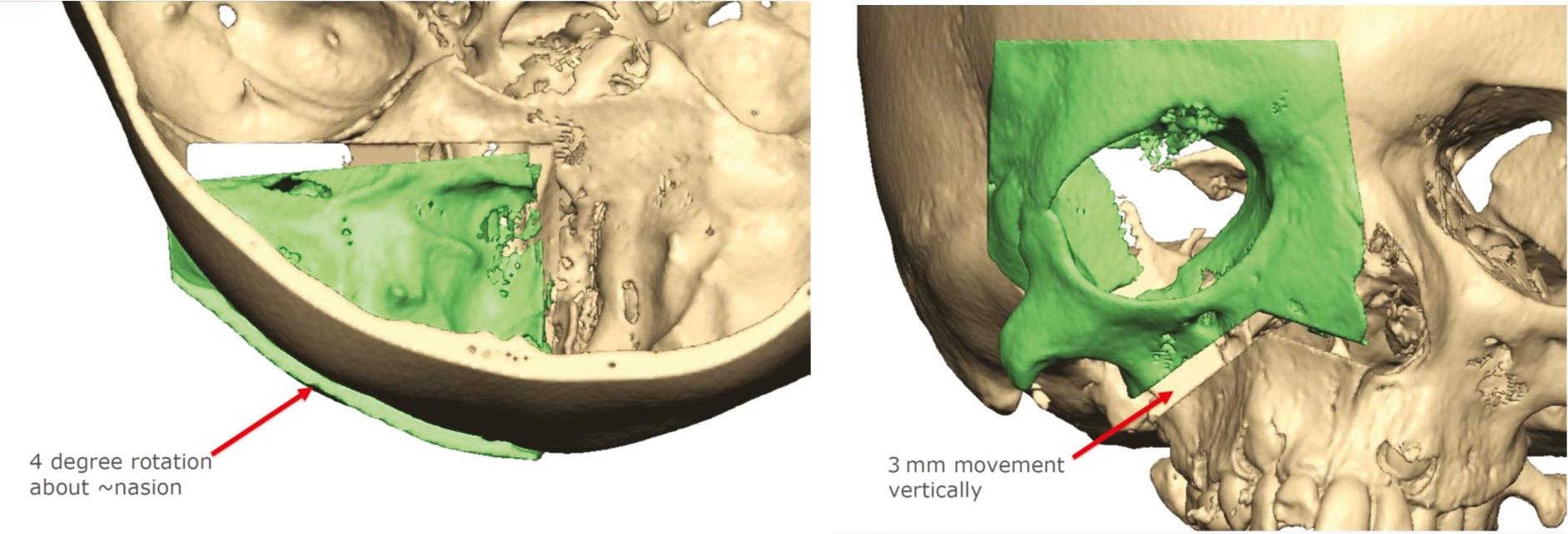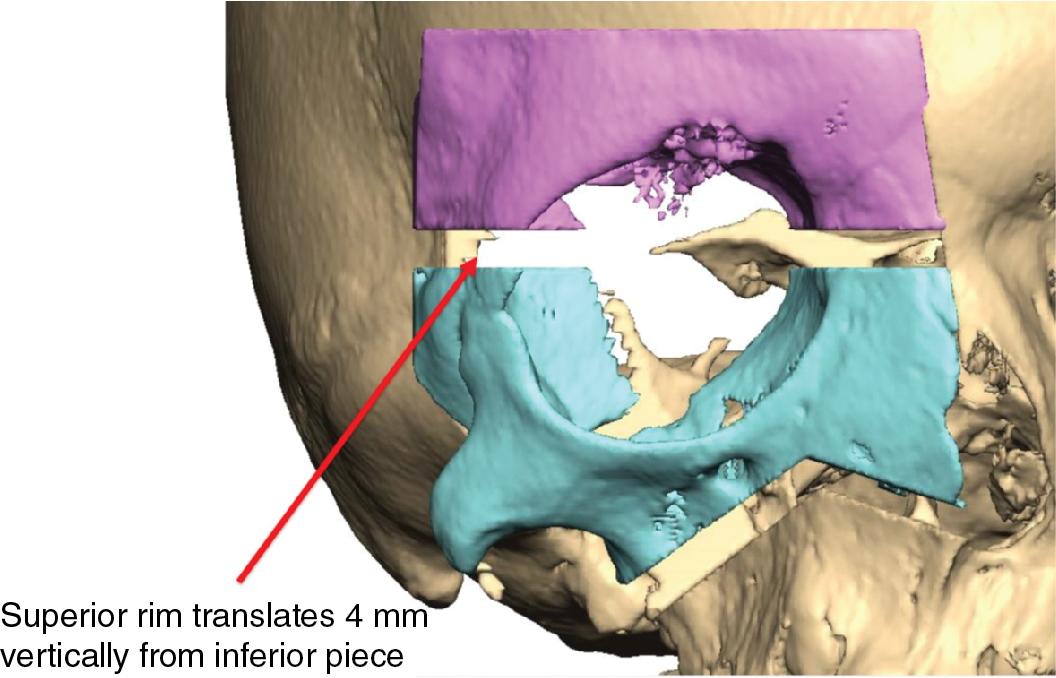Physical Address
304 North Cardinal St.
Dorchester Center, MA 02124
Hypertelorism is defined as increased bony interorbital distance (IOD) and is measured by the interdacryon distance, which is the distance between the most medial osseous aspect of the orbits. Orbital hypertelorism is distinct from telecanthus, which refers to the lateral displacement of the medial canthal tendon. Similarly, interpupillary distance is an inappropriate measure of hypertelorism as it can be significantly impacted by the presence of exotropia. Tessier classified orbital hypertelorism into three categories based on IOD as mild (30–34 mm), moderate (35–40 mm), or severe (>40 mm). , Surgical correction of orbital hypertelorism is possible because in most cases, the distance between the optic canals is thought to be within the normal range, thus allowing mobilization of the orbits and orbital contents without compromising ocular function.
Syndromic craniosynostosis or median facial clefts are conditions commonly associated with hypertelorism.
Surgical options for correction of hypertelorism include orbital box osteotomies and facial bipartition. In a broad sense, these techniques allow for movement of the orbits relative to each other and relative to the skull base, either with the orbits as independent units in the case of orbital box osteotomy or combined with the midface as a monobloc/bipartition osteotomy.
Box osteotomy of the orbits was first described by Tessier as a two-stage procedure and later modified to a single-stage operation. Unlike facial bipartition, orbital box osteotomy allows independent movement of the orbit and thus is an effective technique to correct asymmetric deformities and multiplanar orbital deformities, such as in cases of neurofibromatosis or craniofacial microsomia. Modifications to facial bipartition have also been described that allows for correction of asymmetries in certain cases, but the effect on occlusion limits the degree of freedom in the orbital movements.
Facial bipartition, first described by van der Meulen, has been refined to incorporate modern techniques such as distraction osteogenesis in select patients with sagittal deficiency. In addition to hypertelorism, the indications for facial bipartition include narrowed and high-arched palate and concaved midface such as seen in Apert syndrome. The resection of a bony wedge from the central frontal-nasal region and subsequent rotation of the hemifacial segments flattens the maxillary occlusal plane, corrects the downward vector of the lateral canthi, and increases midface height. Thus, facial bipartition allows medialization and rotation of the orbits while simultaneously achieving expansion and leveling of the maxillary arch.
The choice of operation depends on a number of factors, including the alignment of the maxillary dental arch, the axis of the orbits, the width of the nasal fossa, and the severity of hypertelorism. Facial bipartition has the potential to address abnormalities in the maxillary dental arch and adjust the orbital axis simultaneously. Therefore, it is preferred for patients with narrow and inverted maxillary dental arch or significant downward slanting orbital axis. Facial bipartition is also the preferred choice for large movements compared to box osteotomies.
In patients with syndromic craniosynostosis such as Apert syndrome, monobloc facial bipartition with distraction osteogenesis performed in the mixed dentition stage is a powerful technique to address not only the hypertelorism but also the forehead and midface retrusion that are frequently seen in this patient population. Although this constellation of facial deformities is frequently associated with Apert syndrome, it can also be seen in patients with other syndromic synostosis.
Orbital box osteotomy allows correction of orbital dystopia through translational movements of the orbits in multiple dimensions. Thus, the box osteotomy is an excellent operation for patients with well-aligned occlusion and orbits as it can be performed without alteration of the maxillary occlusion or canthal axis. Further refinements of the orbital box osteotomy include segmentation and addition of internal orbital reconstruction to address external orbital dimension and internal volume asymmetries.
In cases of maxillary arch constriction, facial bipartition can address both the orbital deformity and widen the palate and maxillary arch at the same time. The midline palatal division will create a gap between the central incisors and possible vertical discrepancy if asymmetric facial bipartition is performed. These occlusal alterations will spontaneously correct in most cases during the mixed dentition stage within 3 to 6 months but may need additional orthodontic diastema correction if the patient is in adult dentition. Excessive soft tissue is usually present over the nasal dorsum which frequently will improve over time without resection and can be further contracted using techniques such as soft tissue bolsters, internal plication sutures, or the K-stitch as popularized by Henry Kawamoto MD, DDS. Furthermore, excessive resection along the nasal dorsum can result in unsightly scarring and may interfere with nasal development, leading to the need for subsequent nasal lengthening.
The optimal age for hypertelorism correction remains controversial as surgeons and families must weigh the psychosocial benefits of early correction with the risk of skeletal relapse and growth disturbances. Although infant monobloc and early hypertelorism correction had been proposed in the past, we prefer to opt for a later timepoint after the age of 6 years to perform facial bipartition to achieve more durable results. At this age, the permanent central incisors have erupted, thus decreasing the risk of injury to permanent teeth during midpalatal splitting. In a study of long-term follow-up after surgical correction of hypertelorism, Wan et al. identified age younger than 6 years and preoperative severity as risk factors for relapse requiring repeat correction. Other studies have also found higher rates of relapse in patients with more severe preoperative phenotypes and raised concerns about growth disturbance with early timing of surgery. The senior author (ARK) prefers to operate between 8 and 10 years of age to minimize risk of dental injury to the central incisors and allow for adequate permanent canine descent out of the osteotomy path of a typical orbital box osteotomy. Further delay after 10 years of age would necessitate additional treatment to manage the developing frontal sinuses such as a cranialization procedure.
(See [CR] and [CR] )
Planning for orbital box osteotomy can start with mirroring the contralateral, unaffected orbit. An analysis of the external orbital contour in terms of the vertical position of the superior and inferior orbital rims is then performed to determine the amount of translation and rotation required to correct the specific orbital deformity of the individual patient ( Fig. 10.1 ). The orbital shape should be assessed to determine whether segmentation of the orbit is required ( Fig. 10.2 ). Next, the internal orbital shape and volume is evaluated to determine which orbital walls may require reconstruction, and internal orbital implants can be designed to improve the orbital volume and address enophthalmos or hypoglobus ( Fig. 10.3 ).



Become a Clinical Tree membership for Full access and enjoy Unlimited articles
If you are a member. Log in here